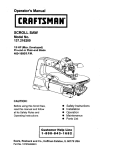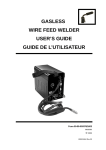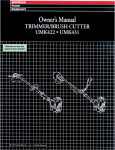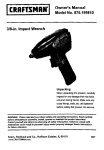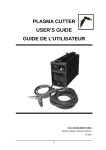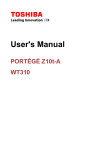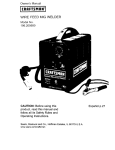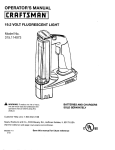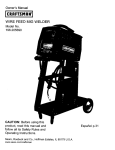Download Century MIG Wire Feed Welder Operator`s manual
Transcript
PART# 0M-I17071002 Operator's Manual 80 AMP WIRE FEED WELDER Made in U.S.A. Form Number 811-597-000 Revision A August 1999 TABLE OF CONTENTS... 2 SAFETY SUMMARY ....... 3 IM PORTANT SAFETY INFORMATION .................. SHOCK HAZARDS ............... FLASH HAZARDS ................ FIRE HAZARDS .................... FUME HAZARDS .................. ADDITIONAL SAFETY INFORMATION ................... ASSEMBLY ...................... UNPACKING THE WELDER PACKING LIST ..................... ASSEMBLE THE FACE SHIELD .............................. POWER SOURCE CONNECTION ................... EXTENSION CORDS ........... SELECTING THE WELDING WIRE ................ INSTALL THE WELDING WIRE ................ OPERATION .................. 3 3 4 5 6 6 8 8 8 8 9 9 9 9 12 DESCRIPTION ................... 12 OPERATING THE WELDER .......................... 12 DUTY CYCLE ..................... 12 INTERNAL THERMAL PROTECTION .................. 12 CONTROLS AND INDICATORS .................... 12 PREPARATIONS FOR WELDING ......................... 13 SETTING UP THE WORK PIECE ................... 13 WELDING POSITIONS ....... 13 PREPARING THE JOINT .... 13 GROUND CLAMP CONNECTION ................. 14 2 LEARNING TO WELD ... 15 GET TO KNOW YOUR WELDER ............... 15 HOLDING THE GUN ........... 15 POSITION THE GUN TO THE WORKPIECE ..... 15 DISTANCE FROM THE WORKPIECE ........... 16 LAYING A BEAD ................. 16 TYPES OF WELD BEADS.. 16 WELDING TECHNIQUES ............. 17 TRAVELING THE GUN ....... TYPES OF WELD BEADS • WELDING POSITIONS ...... MULTIPLE PASS WELDING ......................... SPECIAL WELDING METHODS ....................... SPOT WELDING ................. SPOT WELDING INSTRUCTIONS ............... MAINTENANCE 17 17 18 19 19 19 20 ............. 21 GENERAL MAINTENANCE ............... MAINTENANCE AND CLEANING ............... TESTING FOR A SHORTED NOZZLE ......... MAINTAINING THE WELDER .................. TROUBLESHOOTING ........ SCHEMATIC .................. REPLACEMENT 21 21 21 22 22 24 PARTS LIST ................. 25 LIMITED WARRANTY ... 26 Every craftsman respects the tools with which they work. They know that the tools represent years of constantly improved designs and developments. The true craftsman also knows that tools are dangerous if misused or abused. This symbol indicates that the possibility of toxic gas hazard exists during operation of the step(s) that follow. This symbol indicates that the possibility of being burned by hot slag exists during operation of the step(s) that follow. Reading this operator's manual before using the welder will enable you to do a better, safer job. Learn the welder's applications and limitations as well as the specific potential hazards peculiar to welding. This symbol indicates that the eye protection should be worn to protect against flying debris in the following step(s). IMPORTANT SAFETY INFORMATION READ ALL SAFETY INSTRUCTIONS CAREFULLY before attempting to install, operate, or service this welder. Failure to comply with these instructions could result In personal injury and/or property damage. RETAIN THESE INSTRUCTIONS FUTURE REFERENCE. FOR NOTE: • The following safety alert symbols identify important safety messages in this manual. When you see one of the symbols shown here, be alert to the possibility of personal injury and carefully read the message that follows. This symbol indicates that the possibility of electric shock hazard exists during the operation of the step(s) that follow. This symbol indicates that the possibility of fire hazard exists during the operation of the step(s) that follow. This symbol indicates that the helmet must be worn during the step(s) that follow to protect against eye damage and burns due to flash hazard. This symbol indicates that the possibility of injury or death exists due to improper handling and maintenance of compressed gas cylinders or regulators Published standards on safety are available. They are listed in ADDITIONAL SAFETY INFORMATION at the end of this SAFETY SUMMARY. The National Electrical Code, Occupational Safety and Health Act regulations, local industrial codes and local inspection requirements also provide a basis for equipment installation, use, and service. SHOCK HAZARDS WARNING Electric shock can kill! To reduce the risk of death or serious injury from shock, read, understand, and follow the following safety instructions. In addition, make certain that anyone else who uses this welding equipment, or who is a bystander in the welding area understands and follows these safety instructions as well. 3 * • IMPORTANT! TO REDUCE THE RISK OF DEATH, INJURY, OR PROPERTY DAMAGE, DO NOT A-I-I-EMPT OPERATION of this welding equipment until you have read and understand the following safety summary. Do not, in any manner, come into physical contact with any part of the welding current circuit. The welding current circuit includes: a. the work piece or any conductive material in contact with it, b. the ground clamp, c. the electrode or welding rod, d. any metal parts on the electrode holder. Do not weld in a damp area or come in contact with a moist or wet surface. • Do not attempt to weld if any part of clothing or body is wet. • Do not allow the welding equipment to come in contact with water or moisture. Do not drag welding cables, wire feed gun, or welder power cord through or allow them to come into contact with water or moisture. Do not touch welder, attempt to turn welder on or off if any part of the body or clothing is moist or if you are in physical contact with water or moisture. Do not attempt to plug the welder into the power source if any part of body or clothing is moist, or if you are in physical contact with water or moisture. Do not connect welder ground clamp to or weld on electrical conduit. • Do not alter power cord or power cord plug in any way. • Do not attempt to plug the welder into the power source if the ground prong on power cord plug is bent over, broken off, or missing. • Do not allow the welder to be connected to the power source or attempt to weld if the welder, welding 4 cables, welding site, or welder power cord are exposed to any form of atmospheric precipitation, or salt water spray. Do not carry coiled welding cables around shoulders, or any other part of the body, when they are plugged into the welder. • Do not modify any wiring, ground connections, switches, or fuses in this welding equipment. • Wear welding gloves to help insulate hands from welding circuit. • Keep all liquid containers far enough away from the welder and work area so that if spilled, the liquid can not possibly come in contact with any part of the welder or electrical welding circuit. Replace any cracked or damaged parts that are insulated or act as insulators such as welding cables, power cord, or electrode holder IMMEDIATELY. FLASH HAZARDS WARNING ARC RAYS CAN INJURE EYES AND BURN SKIN! To reduce risk of injury from arc rays, read, understand, and follow the following safety instructions. In addition, make certain that anyone else that uses this welding equipment, or is a bystander in the welding area, understands and follows these safety instructions as well. Do not look at an electric arc without proper protection. A welding arc is extremely bright and intense and, with inadequate or no eye protection, the retina can be burned, leaving a permanent dark spot in the field of vision. A shield or helmet with a number 10 shade filter lens (minimum) must be used. Do not strike a welding arc until all bystanders and you (the welder) have welding shields and/or helmets in place. Do not wear a crackedor broken helmetand replaceany cracked or brokenfilter lenses IMMEDIATELY. Do not allow the uninsulatedportion of the wire feed gun to touch the ground clamp or groundedwork to preventan arc flash from being createdon contact. instructions as well. REMEMBER! Arc welding by nature produces sparks, hot spatter, molten metal drops, hot slag, and hot metal parts that can start fires, burn skin, and damage eyes. • Provide bystanderswith shieldsor helmetsfitted with a #10 shade filter lens. Wear protectiveclothing.The intense lightof the welding arc can burn the skin in much the same way as the sun, even through light-weight clothing.Wear dark clothingof heavy material.The shirt worn should be long sleeved and the collar kept buttonedto protect chest and neck. Protectagainst REFLECTEDARC RAYS.Arc rays can be reflectedoff shiny surfacessuch as a glossy paintedsurface, aluminum,stainless steel, and glass. It is possiblefor your eyes to be injuredby reflectedarc rays even when wearinga protective helmetor shield. If weldingwith a reflectivesurfacebehindyou, arc rays can bounce off the surface,then off the filter lens on the insideof your helmetor shield, then into your eyes. If a reflectivebackgroundexists in your welding area, either removeit or cover it with somethingnon-flammable and non-reflective.Reflectedarc rays can also cause skin burn in additionto eye injury. Do not wear flammable hair preparations. Do not weld in an area until it is checked and cleared of combustible and/or flammable materials. BE AWARE that sparks and slag can fly 35 feet and can pass through small cracks and openings. If work and combustibles cannot be separated by a minimum of 35 feet, protect against ignition with suitable, snug-fitting, fire resistant, covers or shields. • Do not weld on walls until checking for and removing combustibles touching the other side of the walls. • Do not weld, cut, or perform other such work on used barrels, drums, tanks, or other containers that had contained a flammable or toxic substance. The techniques for removing flammable substances and vapors, to make a used container safe for welding or cutting, are quite complex and require special education and training. • Do not strike an arc on a compressed gas or air cylinder or other pressure vessel. Doing so will create a brittle area that can result in a violent rupture immediately or at a later time as a result of rough handling. • Do not weld or cut in an area where the air may contain flammable dust (such as grain dust), gas, or liquid vapors (such as gasoline). • Do not handle hot metal, such as the workpiece or electrode stubs, with bare hands. FIRE HAZARDS WARNING FIRE OR EXPLOSION CAN CAUSE DEATH, INJURY, AND PROPERTY DAMAGE! To reduce risk of death, injury, or property damage from fire or explosion, read, understand, and follow the following safety instructions. In addition, make certain that anyone else that uses this welding equipment, or is a bystander in the welding area, understands and follows these safety Do not wear gloves or other clothing that contain oil, grease, or other flammable substances. Wear leather gloves, heavy long sleeve shirt, cuffless trousers, hightopped shoes, helmet, and cap. As necessary, use additional protective clothing such as leather jacket or 5 sleeves, fire resistant leggings, or apron. Hot sparks or metal can lodge in rolled up sleeves, trouser cuffs, or pockets. Sleeves and collars should be kept buttoned and pockets eliminated from the shirt front. steel), unless the coating is removed. Make certain the area is well ventilated, and the operator and all bystanders are wearing air-supplied respirators. Do not weld, cut, or heat lead, zinc, cadmium, mercury, beryllium, or similar metals without seeking professional advice and inspection of the ventilation of the welding area. These metals produce EXTREMELY TOXIC fumes which can cause discomfort, illness, and death. Have fire extinguishing equipment handy for immediate use! A portable chemical fire extinguisher, type ABC, is recommended. • Wear ear plugs when welding overhead to prevent spatter or slag from falling into ear. • Make sure welding area has a good, solid, safe floor, preferably concrete or masonry, not tiled, carpeted, or made of any other flammable material. • Protect flammable walls, ceilings, and floors with heat resistant covers or shields. • Do not weld or cut in areas that are near chlorinated solvents. Vapors from chlorinated hydrocarbons, such as trichloroethylene and perchloroethylene, can be decomposed by the heat of an electric arc or its ultraviolet radiation. These actions can cause PHOSGENE, a HIGHLY TOXIC gas to form, along with other lung and eye-irritating gasses. Do not weld or cut where these solvent vapors can be drawn into the work area or where the ultraviolet radiation can penetrate to areas containing even very small amounts of these vapors. • Do not weld in a confined area unless it is being ventilated or the operator (and anyone else in the area) is wearing an air-supplied respirator. • Stop welding if you develop momentary eye, nose, or throat irritation as this indicates inadequate ventilation. Stop work and take necessary steps to improve ventilation in the welding area. Do not resume welding if physical discomfort persists. Check welding area to make sure it is free of sparks, glowing metal or slag, and flames before leaving the welding area. FUME HAZARDS WARNING FUMES, GASSES, AND VAPORS CAN CAUSE DISCOMFORT, ILLNESS, AND DEATH! To reduce risk of discomfort, illness, or death, read, understand, and follow the following safety instructions. In addition, make certain that anyone else that uses this welding equipment or is a bystander in the welding area, understands and follows these safety instructions as well. • • 6 Do not weld in an area until it is checked for adequate ventilation as described in ANSI standard #Z49.1. If ventilation is not adequate to exchange all fumes and gasses generated during the welding process with fresh air, do not weld unless you (the welder) and all bystanders are wearing air-supplied respirators. Do not heat metals coated with, or that contain, materials that produce toxic fumes (such as galvanized ADDITIONAL INFORMATION SAFETY For additional information concerning welding safety, refer to the following standards and comply with them as applicable. • ANSI Standard Z49.1 -- SAFETY IN WELDING AND CUTTING -obtainable from the American Welding Society, 550 NW Le Jeune Road, Miami, FL 33126 Telephone (800) 443-9353, Fax (305) 443-7559 www.amweld.org or www.aws.org • ANSI StandardZ87.1 -- SAFE PRACTICEFOR OCCUPATIONAND EDUCATIONALEYE AND FACE PROTECTION-- obtainablefrom the American NationalStandards Institute, 11 West 42ndSt., New York, NY 10036 Telephone (212) 642-4900, Fax (212) 398-0023 - www.ansi.org • NFPA Standard 51B -- CUTTING AND WELDING PROCESS -obtainable from the National Fire Protection Association, 1 Batterymarch Park, P.O. Box 9101, Quincy, MA 02269-9101 Telephone (617) 770-3000, Fax (617) 770-0700 - www.nfpa.org • OSHA Standard 29 CFR, Part 1910, Subpart Q., WELDING, CUTTING AND BRAZING -- obtainable from your state OSHA office or U. S. Dept. of Labor OSHA, Office of Public Affairs, Room N3647, 200 Constitution Ave. NW Washhington, DC 20210 www.osha.gov • CSA Standard W117.2 -- Code for SAFETY IN WELDING AND CUI-rlNG.obtainable from Canadian Standards Association, 178 Rexdale Blvd. Etobicoke, Ontario M9W 1R3 - www.csa.ca American Welding Society Standard A6.0. WELDING AND CUI-FING CONTAINERS WHICH HAVE HELD COMBUSTIBLES. -- obtainable from the American Welding Society, 550 NW Le Jeune Road, Miami, FL 33126 Telephone (800) 443-9353, Fax (305) 443-7559 - www.amweld.org or www.aws.org 7 The following procedures describe the process required to assemble, install, maintain, and prepare to weld with your new wire feed 80 amp ac welder• PACKING LIST Table 1 contains a list of the items you will find packed in the carton• Table 1. Packing List UNPACKING THE WELDER 1. Remove any cartons or bags containing parts/accessories. 2. Open the cartons or bags packed with your welder and inspect their contents for damage• Report any missing or damaged items immediately• 3. 4. Layout the parts and compare them to the illustrations in Figure 1 and the packing list in Table 1 to familiarize yourself with the parts and what they are called• This will help you when reading the manual• Grasp the top handle of the welder and lift the welder out of the carton• PART NO. 332-239-000 930-405-000 ITEM Welder 1 Face Shield 1 8 1. Welder Parts/Accessories 3 Shaded Lens 1 Clear Lens 1 1 2 334-203-000 Nozzle 1 331-469-001 Wire .030 Fluxcore (1/2#) 804-502-000 Card, Registration 1 811-597-000 Manual, Instruction 1 . Figure Handle Screws Contact Tip, 0.030 Face Shield Contact Tip 1 334-160-000 • Weld Gun Nozzle Face Shield Handle Parts Bag ASSEMBLE SHIELD Welding Wire QTY. THE FACE Press one of the lens retainer tabs (located in the rectangular lens cavity inside the face shield) toward the center of the lens cavity and lift the retainer out of the cavity (may require the use of a straight blade screw driver to pry the tab). Insert the clear plastic lens then the shaded lens into the rectangular lens cavity in the face shield• The lenses are put in from the inside and the clear lens goes in first to protect the shaded lens. Insert the lens retainer in place behind the shaded lens and snap the tabs into the holding slots at the ends of the lens cavity to secure the lenses in place• . Place the face shield handle over the mating holes in the face shield and use the provided handle screws to mount the face shield handle to the face shield. POWER SOURCE CONNECTION WARNING High voltage danger from power source! Consult a qualified electrician for proper installation of receptacle at the power source. • This welder must be grounded while in use to protect the operator from electrical shock. If you are not sure if your outlet is properly grounded, have it checked by a qualified electrician. Do not cut off the grounding prong or alter the plug in any way and do not use any adapters between the welder's power cord and the power source receptacle. Make sure the POWER switch is OFF then connect your welder's power cord to a properly grounded 120 Vac, 60 Hz, single phase, 15 amp power source. Do not operate this welder if the source voltage is less than 105 Vac or greater than 132 Vac. Contact a qualified electrician if this problem exists. Improper performance and/or damage to the welder will result if operated on inadequate or excessive power. EXTENSION CORDS For optimum welder performance, an extension cord should not be used unless absolutely necessary. If necessary, care must be taken in selecting an extension cord appropriate for use with your specific welder. Select a properly grounded extension cord that will mate directly with the ac power source receptacle and the welder power cord without the use of adapters. Make certain that the extension cord is properly wired and in good electrical condition. Extension cords must fit the following wire size guidelines: • 0-25 ft. requires #12 gauge • Do not use an extension cord over 25 ft. in length SELECTING WIRE THE WELDING This welder uses only four inch spools of 0.030 inch (0.8mm) self shielding fluxcore wire, AWS classification number E71T-GS. Steel from 18 gauge up to 3/16 inch thick can be welded with this wire. NOTE: • Metal thinner than 18 gauge cannot be welded with this machine. Attempting to do so will cause burn through (blowing holes) in the metal you are intending to weld. • If a spool has developed heavy oxidation, the only solution to the problem is to discard the spool of wire. If you have an oxidized spool of wire, do not discard it until you have unspooled a few turns of wire to see if the wire further down on the spool is in usable condition, if not, - discard the spool. INSTALL WIRE THE WELDING WARNING Electric shock can kill! Always turn the POWER switch OFF and unplug the welder's power cord from the ac power source before installing wire. 1. . . Remove the nozzle and contact tip from the end of the gun assembly. Remove the drive tension by unscrewing (ALL THE WAY in a counter-clockwise direction) the tension adjusting screw. Unwrap the spool of wire then find the leading end of the wire (it goes through a hole in the outer edge of the spool and is bent over the 9 spool edge to prevent the wire from unspooling) BUT DO NOT UNHOOK IT YET. Place the spool on the spindle in such a manner that when the wire . comes off the spool, it will look like the top illustration in Figure 2. ( Right Way ii o Figure . Wrong Way . Figure . 2. Proper wire Installation Adjust the drive brake hardware on the top of the spool of wire (see Figure 3). a. With one hand, turn the wire spool and continue turning it while adjusting the tension. b. With your free hand, tighten (turn clockwise) the wing nut. c. Stop tightening when drag is felt on the wire spool that you are turning, then stop hand turning the wire spool. . . 3. Drive Brake Assembly Adjust the drive brake tension. The purpose of the drive brake is to cause the spool of wire to stop turning at nearly the same moment that wire feeding stops. After checking to make sure that your welder is disconnected from the ac power source, free the leading end of the wire from the spool, but do not let go of it until told to do so, or the wire will unspool itself. Using a wire cutter, cut the bent end off the leading end of the wire so that only a straight leading end remains. Hold the tension arm up off the drive roller and insert the leading end of the wire into the inlet guide tube. Then push it across the drive roller and into the gun assembly about six inches. 10. Line the wire up in the outside groove of the drive roller, then allow the drive tension arm to drop onto the drive roller. 11. 10 Tighten (turn clockwise) the tension adjusting screw until the tension roller is applying enough force on the wire to prevent it from slipping out of the drive assembly. 12. Let go of the wire. 13. Plug the welder's power cord into the ac power source. Adjust the HEAT selection switches, on the front of the welder, to any of the four heat settings. WARNING ARC RAYS CAN INJURE EYES! To reduce the risk of arc flash, make certain that the welding wire, when it finally comes out of the end of the gun, does not touch the ground clamp or any grounded piece of metal. IMPORTANT! The welding wire is carrying welding current whenever the welder is turned on-WHETHER THE TRIGGER IS PULLED OR NOT! WARNING ARC RAYS CAN INJURE EYES! To reduce the risk of arc flash, make certain that the wire coming out of the end of the gun does not come in contact with the ground clamp or any grounded material during the drive tension setting process or arcing will occur. a. b. NOTE: 14. Pull the trigger on the welding gun to feed the wire through the gun assembly. out past the end of the gun, release the trigger. 17. Slide the contact tip over the wire (protruding from the end of the gun). Screw the contact tip into the end of the gun and hand tighten securely. 18. Install the nozzle on the gun assembly. 19. Cut off the excess wire that extends past the end of the nozzle. 20. Set the wire drive tension. If TOO MUCH tension is applied, the wire will slip on the drive roller or will not be able to be fed at all. If TOO LITTLE tension is applied, the spool of wire will want to unspool itself. Readjust the drive brake tension as necessary to correct for either problem. 15. When at least an inch of wire sticks 16. Install the supplied 0.030 inch (0.8mm) size contact tip. Pull the trigger on the gun. Turn the drive tension adjustment knob clockwise, increasing the drive tension until the wire seems to feed smoothly with out slipping. c. Block the end of the nozzle by holding it up against something that doesn't conduct electricity, such as a block of wood or a concrete floor, then trigger the gun again, the wire should slip at the drive roller. However, if the wire bird-nests at the drive roller, rethread the drive system using less drive tension and try again. When the drive tension is set correctly, there should be no slippage between the wire and the drive roller. But if an obstruction occurs along the wire feed path, the wire should then slip on the drive roller. 11 DESCRIPTION Table 3. Duty Cycle Ratings Your new Wire Feed welder is designed for maintenance and sheet metal fabrication. The welder consists of a single-phase power transformer, and a unique built-in control/feeder. This welder is capable of welding with 0.030 inch self-shielding flux-core wire. Now you can weld 18 gauge sheet metal up to 3/16 inch with a single pass. You can weld 1/4 inch steel with beveling and multiple pass techniques. Table 2 lists your wire feed welder specifications. OPERATING Required Cycle Rating Welding Time Resting Time 20% 2 minutes 8 minutes 40% 4 minutes 6 minutes 60% 6 minutes 4 minutes 80% 8 minutes 2 minutes 100% 10 minutes 0 minutes Do not constantly exceed the duty cycle or damage to this welder can result. 120 Vac 60 - 120 Amps Frequency Secondary (output) volts Secondary (output) amps Duty Cycle Rating at 80 amps Open Circuit Volts (Max.) Maximum CAUTION Table 2. Welder Specifications Primary (input) volts Welding Range Primary (inputs) Amps Phase Duty INTERNAL THERMAL PROTECTION 20 Single 60 Hz 17 80 20% 25 Vac THE WELDER If you exceed the duty cycle of your welder, the HIGH/LOW switch will illuminate, an internal thermal protector will open and shut off all welder functions. After cooling, the thermal protector will automatically reset and the welder will function normally again. CONTROLS AND INDICATORS DUTY CYCLE The duty cycle rating of a welder defines how long the operator can weld and how long the welder must be rested and cooled. Duty cycle is expressed as a percentage of 10 minutes and represents the maximum welding time allowed. The balance of the 10 minute cycle is required for cooling. Your new welder has a duty cycle rating of 20% at the CSA rated output of 80 amps. This means that you can weld for two (2) minutes out of 10 with the remaining eight (8) minutes required for cooling. (See the table 3.) 12 WARNING ELECTRIC SHOCK CAN KILL! To remove the risk of electric shock, be aware that the POWER switch, when OFF, does not remove power from all internal circuitry in the welder. The HIGH/LOW RANGE SWITCH controls the main power to the welder lights up when the dugy cycle has been exceeded and selects the two main heat ranges. When the switch is OFF, there is still power to some areas of the welder. When working inside the welder or when removing panels on the welder, make sure the welder is unplugged from the wall outlet. The MINIMAX SELECTOR allows you to select minimum and maximum heat settings within the high and low ranges. Refer to the instruction label inside the welder's hood for suggestions on which heat setting to use for your welding job. PREPARATIONS ,I 1 I \ FOR WELDING An important factor in making a satisfactory weld is preparation. This includes studying the process and equipment and then practice welding before attempting to weld finished product. An organized, safe, convenient, comfortable, well-lighted work area should be available to the operator. The work area should specifically be free of all flammables with both a fire extinguisher and bucket of sand available. To properly prepare for welding, it is necessary to: • Prepare an organized, well lighted work area (see Figure 4). • Provide protection for the eyes and skin of the operator and bybystanders. • Set up the work piece and make the ground clamp connection. • Select the electrode. • Adjust the heat control. WARNING Exposure to a welding arc is extremely harmful to the eyes and skin. Prolonged exposure to a welding arc can cause blindness and burns. Never strike an arc or begin welding unless you are adequately protected. Wear flameproof welding gloves, heavy long sleeved shirt, cuffless trousers, high topped shoes and a welding helmet. Figure 4. Work Surface and Equipment SETTING UP THE WORK PIECE WELDING POSITIONS Welding with an ac wire welder can be done in any of three basic positions: Flat, Horizontal, and Vertical. Flat welding is generally easier, faster and allows for better penetration. The heat (amperage) selections will be affected by the positions. Vertical welding is usually only attempted when using a dc welder. If possible, the work piece should be positioned so that the bead will run on a flat surface. PREPARING THE JOINT For effective welding, the surfaces to be joined must be free of dirt, rust, scale, oil or paint. Welding on metals not properly cleaned will cause a brittle and porous weld. If the base metal pieces to be joined are thick or heavy, it may be necessary to bevel the edges, with a metal grinder, at the point of contact, as in Figure 5. The angle of the bevel should be approximately 60 degrees. INCORRECT CORRECT Figure 5. Workpiece Preparation 13 WARNING WARNING ARC RAYS CAN INJURE EYES AND BURN SKIN! To reduce the risk of injury from arc rays, never strike a welding arc until you, and all bystanders in the welding area, have welding helmet or shield in place and are wearing the recommended protective clothing. DO NOT CONTINUE unless you have read, understand and intend to follow the entire SAFETY SUMMARY provided at the front of this manual. To help prevent eye injuries when grinding, always wear goggles. The grinder must also be inspected to verify that it is in good condition. See the chart, TYPES OF WELD JOINTS, in Figure 6, for detailed instructions for preparing the weld joint. During the welding, the work pieces will become hot and will tend to expand. The expansion may cause the pieces to shift from the regular position. If possible, the work pieces should be clamped into the position they are to occupy when the welding is completed. 45° PLATE Ground Clamp Connection The ground clamp connection is part of the current circuit. A poor connection at the ground clamp will waste power and heat. Scrape away dirt, rust, scale, oil or paint. Make sure the ground clamp touches the metal. BUTT WELD JOINTS 60 ° PLATE 37.5 ° SINGLE V JOINT 60 ° SINGLE BEVEL JOINT DOUBLE JOINT i_PLATE DOUBLE BEVEL JOINT j I -"11"- _-/ Y VEE JOINT II 6o° OPEN JOINT l ..... _)( SHOULDER EDGE WELD JOINTS SINGLE STRAP JOINT DOUBLE STRAP FILLET T-JOINT JOINT Figure 6. Types of Weld Joints 14 "_ FEATHER EDGE 1/8" OR MORE _ILLET SINGLE "x_ 1/4,, OR MORE DOUBLE VEE JOINT I V JOINT 60_.. 1/16" TO1/8" X 3/32" TO 1/8" OLOSED JOINT 6o o _f .,,.. DOUBLE FILLET T-JOINT GET TO KNOW YOUR WELDER Whether you have welded before or not, it is important that you become familiar with your new welder, its controls, and the results achieved at different settings. We strongly recommend that you practice your new welder on scrap metal trying different heat settings, base metal thicknesses, and welding positions for each type. By doing this you will gain a feel for how changes in these welding variables affect the weld. The self taught welder learns through a process of trial and error. The best way to teach yourself how to weld is with short periods of practice at regular intervals. All practice welds should be done on scrap metal that can be discarded. Do not attempt to make any repairs on valuable equipment until you have satisfied yourself that your practice welds are of good appearance and free of slag or gas inclusions. What you fail to learn through practice will be learned through mistakes and re-welds later on. HOLDING THE GUN The best way to hold the welding gun is the way that feels most comfortable to you. While practicing to use your new welder, experiment holding the gun in different positions until you find the one that seems to work best for you. Position The Gun To The Workpiece There are two angles of the gun nozzle in relation to the work piece that must be considered when welding. 1. Angle A (Figure 7) can be varied, but in most cases the optimum angle will be 60 degrees. The point at which the gun handle is parallel to the work piece. If angle A is increased, penetration will increase. If angle A is decreased, penetration will decrease also. m m m Angle A Figure . 7. Gun Position, Angle A Angle B (Figure 8) can be varied for two reasons: to improve the ability to see the arc in relation to the weld puddle and to direct the force of the arc. I I Angle B Figure 8. Gun Position, Angle B The force of the welding arc follows a straight line out of the end of the nozzle. If angle B is changed, so will the direction of arc force and the point at which penetration will be concentrated. On a butt weld joint, the only reason to vary angle B from perpendicular (straight up) to the work piece would be to improve visibility of the weld puddle. In this case, angle B can be varied anywhere from zero to 45 degrees with 30 degrees working about the best. On a fillet weld joint, the nozzle is generally positioned in such a manner so as to split the angle between the horizontal and vertical members of the weld joint. In most cases, a fillet weld will be 45 degrees. 15 Distance From The Workpiece The end of the welding gun is designed with the contact tip recessed from the end of the nozzle and the nozzle electrically insulated from the rest of the gun. This permits the operator to actually rest the nozzle on the work piece and drag it along while welding. This can be very helpful to beginning welders to steady the gun, allowing the welder to concentrate on welding technique. If the nozzle is held off the work piece, the distance between the nozzle and the work piece should be 1/4 inch to 3/8 inch depending on the gauge of the metal and the amount of penetration desired. Moving closer to the workpiece increases penetration. Moving away from the workpiece decreases penetration. The correct distance must still be maintained, or the arc may begin sputtering, signaling a loss in welding performance. LAYING A BEAD WARNING EXPOSURE TO A WELDING ARC IS EXTREMELY HARMFUL TO THE EYES AND SKIN! Prolonged exposure to the welding arc can cause blindness and burns. Never strike an arc or begin welding until you are adequately protected. Wear flameproof welding gloves, A heavy long sleeved shirt, cuffless trousers, high topped shoes and a welding helmet. 16 WARNING ELECTRIC SHOCK CAN KILL! To prevent ELECTRIC SHOCK, do not perform any welding while standing, kneeling, or lying directly on the grounded work. TYPES OF WELD BEADS The following paragraphs discuss the most commonly used arc welding beads. IMPORTANT! The wire in this welder is always electrically energized whenever the power is ON and will arc whenever brought into contact with any electrically conductive materials that the ground clamp of the welder is connected to or with which it is in contact. Therefore, it is best to clip the wire back to the contact tip so that you don't create an arc when lining up on the seam to be welded. Once you have the gun in position with the wire lined up on the weld joint, cover your face with the face shield, pull the trigger and the arc will start. In a second or two you will notice a weld puddle form and the base of the bead beginning to build. It is now time to begin to travel with the gun. If you are just learning to weld, travel by simply dragging the gun in a straight line and at a steady speed along the weld joint. Try to achieve a weld with the desired penetration and a bead that is fairly flat and consistent in width. As you become more familiar with your new welder and better at laying some simple weld beads, you can begin to try some different welding techniques to improve, and add versatility to your welding skills. TRAVELING THE GUN Gun travel refers to the movement of the gun along the weld joint and is broken into two elements: Direction and Speed. A solid weld bead requires that the welding gun be moved steadily and at the right speed along the weld joint. Moving the gun too fast, too slow, or erratically will prevent proper fusion or create a lumpy, uneven bead. 1. TRAVEL DIRECTION 2. TRAVEL SPEED is the rate at which the gun is being pushed or pulled along the weld joint. For a fixed heat setting, the faster the travel speed, the lower the penetration and the lower and narrower the finished weld bead. Likewise, the slower the travel speed, the deeper the penetration and the higher and wider the finished weld bead. TYPES , is the direction the gun is moved along the weld joint in relation to the weld puddle. The gun is either PUSHED (see Figure 9) into the weld puddle or PULLED away from the weld puddle. OF WELD BEADS The STRINGER BEAD (Figure 10) is formed by traveling with the gun in a straight line while keeping the wire and nozzle centered over the weld joint. This is the easiest type of bead to make and is the type you have been using up to this point. Figure 10. Stringer Weld Bead For most welding jobs you will pull the gun along the weld joint to take advantage of the greater weld puddle visibility. However, there are a few applications where pushing the gun may provide some advantages: The WEAVE BEAD (Figure 11)is used when you want to deposit metal over a wider space than would be possible with a stringer bead. It is made by weaving from side to side while traveling with the gun. It is best to hesitate momentarily at each side before weaving back the other way. VERTICAL WELDING can be done by starting at the top of a weld joint and pulling the gun down toward the bottom. However, in the event that puddle control becomes difficult (such as the puddle wanting to run downward), starting a vertical weld at the bottom of a weld joint and pushing the gun up toward the top will help to overcome this problem. Figure 11. Weave Weld Bead , Figure 9. Gun Travel Direction 17 WELDING POSITIONS There are three basic welding positions: flat, horizontal, and vertical. . The FLAT POSITION (Figure 12) is the easiest of the welding positions and is probably the one you have been using thus far. It is best if you can weld in the flat position if at all possible as good results are easier to achieve. Figure 13. Horizontal Position Weld . Figure 12. Flat Position Weld . The HORIZONTAL POSITION (Figure 13) is next in difficulty level. It is performed very much the same as the flat weld except that angle B (see POSITION OF THE GUN TO THE WORK PIECE, above) is such that the wire, and therefore the arc force, is directed more toward the metal above the weld joint. This is to help prevent the weld puddle from running downward while still allowing slow enough travel speed to achieve good penetration. A good starting point for angle B is about 30 degrees DOWN from being perpendicular to the work piece. The VERTICAL POSITION (Figure 14) is the next most difficult position. Pulling the gun from top to bottom may be easier for many people, but in some instances it can be difficult to prevent the puddle from running downward. Pushing the gun from bottom to top may provide better puddle control and allow slower rates of travel speed to achieve deeper penetration. When vertical welding, angle B (see POSITION OF GUN TO THE WORK PIECE, above) is usually always kept at zero, but angle A will generally range from 45 to 60 degrees to provide better puddle control. Figure 14. Vertical Position Weld 18 MULTIPLE PASS WELDING Butt Weld Joints. In PREPARING THE WORK PIECE, we discussed the need for edge preparation on thicker materials by grinding a bevel on the edge of one or both pieces of the metal being joined. When this is done, a V is created, between the two pieces of metal, that will have to be welded closed. In most cases more than one pass or bead will need to be rayed into the joint to close the V. Laying more than one bead into the same weld joint is known as a multiple-pass weld. NOTE: WHEN USING SELFSHIELDING FLUX-CORE WIRE it is very important to thoroughly chip and brush the slag off each completed weld bead before making another pass or the next pass will be of poor quality. The illustrations in Figure 15 show the sequence for laying multiple pass beads into a single V butt joint. Root Pass Lap Joint Welded In Three Passes Figure 16. Triple Pass Lap And T Weld Joint SPECIAL WELDING METHODS SPOT WELDING The purpose of a spot weld is to join pieces of metal together with a spot of weld instead of a continuous weld bead. There are three methods of spot welding: Burn-Through, Punch and Fill, and Lap (see Figure 17). Each has advantages and disadvantages depending on the specific application as well as personal preference. Pass LAPSPOT PUNCH ANDFILL BURNTHROUGH Figure Figure 15. Triple Pass V Butt Joint 1. Most fillet weld joints, on metals of moderate to heavy thickness, will require multiple pass welds to produce a strong joint. The illustrations in Figure 16 show the sequence of laying multiple pass beads into a T fillet joint and a lap fillet joint. 17. Spot Weld Methods The BURN-THROUGH METHOD welds two overlapped pieces of metal together by burning through the top piece and into the bottom piece. 0.030 inch self-shielding flux-core wire should not be used with the burnthrough method unless the metal is 19 VERY thin or excessive filler metal build-up and minimal penetration is acceptable• Always select the HIGH heat setting with the burn-through method prior to making a spot weld. 2• The PUNCH AND FILL METHOD produces a weld with the most finished appearance of the three spot weld methods. In this method, a hole is punched or drilled into the top piece of metal and the arc is directed through this hole to penetrate into the bottom piece. The puddle is allowed to fill up the hole leaving a spot weld that is smooth and flush with the surface of the top piece. Select the, heat setting, as if you were welding the same thickness material with a continuous bead. 3. The LAP SPOT METHOD directs the welding arc to penetrate the bottom and top pieces, at the same time, right along each side of the lap joint seam. Select the heat setting as if you were welding the same thickness material with a continuous bead. 20 SPOT WELDING • . . . . INSTRUCTIONS Select the heat setting recommended above for the method of spot welding you intend to use. Hold the nozzle piece completely perpendicular to and about 1/4 inch off the work piece• Pull the trigger on the gun and release it when it appears that the desired penetration has been achieved. Make practice spot welds on scrap metal, varying the length of time you hold the trigger, until a desired spot weld is made. Make spot welds on the actual work piece at desired locations. GENERAL MAINTENANCE periodically. replace fashion This welder has been engineered to give many years of trouble-free service providing that a few very simple steps are taken to properly maintain it. 1. 2. . Keep the wire drive compartment lid closed at all times unless the wire needs to be changed or the drive tension needs adjusting. Keep all consumables (contact tips, nozzles, and gun liner) clean and replace when necessary. See CONSUMABLE MAINTENANCE AND TROUBLESHOOTING later in this section for detailed information. THE WARNING ELECTRIC SHOCK CAN KILL! To reduce the risk of electric shock, always unplug the welder from its ac power source before removing side panels. MAINTENANCE IT IS VERY AND CLEANING IMPORTANT TO MAINTAIN THE CONSUMABLES TO AVOID NEED FOR PREMATURE REPLACEMENT OF THE THE GUN ASSEMBLY. CAUTION KEEP THE NOZZLE CLEAN! During the welding process, spatter and slag will build up inside the nozzle and must be cleaned out and/or FRONT-END OF THE TO GUN of the inaction will REQUIRE THE REPLACEMENT OF THE ENTIRE GUN ASSEMBLY. 1. Stop welding and clean any accumulated slag or spatter from the nozzle every 5 to 10 minutes of welding time. 2. When welding overhead, if any molten metal drips from the weld puddle and falls into the nozzle, STOP WELDING IMMEDIATELY and clean the nozzle. Replace power cord, ground cable, ground clamp, or gun assembly when damaged or worn. Periodically clean dust, dirt, grease, etc. from your welder. Every six months or as necessary, remove the side panels from the welder and air-blow any dust and dirt that may have accumulated inside the welder. to clean ASSEMBLY, which is NOT REPLACEABLE. The results . . Failure the nozzle in a timely WILL CAUSE DAMAGE If the slag cannot be thoroughly cleaned from the nozzle, REPLACE THE NOZZLE! Failure to keep the nozzle adequately cleaned can result in the following problems: A SHORTED nozzle results when spatter buildup bridges the insulation in the nozzle allowing welding current to flow through it as well as the contact tip. When shorted, a nozzle will steal welding current from the wire whenever it contacts the grounded work piece. This causes erratic welds and reduced penetration. In addition, a shorted nozzle overheats the end of the gun which can DAMAGE the front-end of the gun. TESTING NOZZLE FOR A SHORTED Arcing between the nozzle and the work piece ALWAYS means the nozzle is shorted, but this can be hard to detect through the lens of a welding helmet. The following testing method is another way to tell if a nozzle is shorted. With the welder unplugged from the ac power source, touch the probes of an ohmmeter or continuity tester to the end of the contact tip and the outside of the 21 nozzle. If there is any continuity at all, the nozzle IS shorted. Clean or replace as needed. The following paragraphs describe the procedures required to maintain and troubleshoot your welder. MAINTAINING WELDER THE Except for internal and external cleaning, cleaning the nozzle, and occasionally retightening screws, there is no periodic maintenance recommended for your welder. TROUBLESHOOTING The following TROUBLESHOOTING information is provided as a guide to help resolve some of the more common problems that could be encountered. Table 4 is a troubleshooting table provided to help you determine a possible remedy when you are having a problem with your welder. This table does not provide all possible solutions, only those possibilities considered to likely be common faults. The table consists of a TROUBLE or symptom, a POSSIBLE CAUSE for that symptom, and a POSSIBLE REMEDY for that symptom. 22 Table 4. Troubleshooting TROUBLE Dirty, porous brittle weld Wire feed works but no arc POSSIBLE CAUSE Nothing works Clean or replace nozzle 1. Bad ground or loose connection 1. Check ground and connections tighten as necessary 2. Check connection to gun or replace gun to gun or 1. Faulty wire speed circuit board 2. No tension on the drive roller 1. Replace wire speed circuit board 3. Faulty drive motor (very rare) 3. Replace drive motor 1. Faulty trigger on gun 2. Faulty transformer (rare) 3. Exceeded duty cycle; thermal protector opened 1. Replace trigger 2. Replace transformer 3. Allow welder to cool at 1. Loose connection machine Low output or nonpenetrating weld. inside 2. Too long or improper extension cord Wire burns back to contact tip Ground clamp and/or cable gets hot Gun nozzle arcs to work surface 2. Adjust the drive tension least 10 minutes (observe and maintain proper duty cycle) 1. Blow inside of machine out with compressed air, clean and tighten all connections 2. See EXTENSION CORD USE in this manual 3. Wrong stype or size wire 3. Use only 0.030 (0.8mm) E71T-GS self shielding fluxcore wire 4. Poor ground connection 4. Reposition clamp and check cable to clamp connection 5. Wrong size contact tip 5. Use only 0.030 inch (0.8mm) contact tip 6. Tighten gun or replace gun 6. Loose gun connection or faulty gun assembly 1. Too much tension on drive roller Wire is birdnesting at the drive roller REMEDY Plugged welding nozzle 2. Bad connection faulty gun Arc works but not feeding wire. POSSIBLE 2. Gun liner worn or damaged 3. Contact tip is clogged or damaged 4. Liner is stretched or is too 1. Adjust the drive tension see INSTALLING THE WELDING WIRE 2. Replace gun 3. Replace contact tip 4. Trim liner to proper length long 1. Gun liner is worn or 1. Replace gun damaged 2. Liner stretched or is too 2. Trim liner for proper length long 3. Wrong size contact tip 4. contact tip clogged or damaged Bad connection from cable to 3. Use correct size contact tip 4. Replace contact tip clamp Tighten connection cable or replace Slag buildup inside nozzle or nozzle is shorted Clean or replace nozzle as needed 23 Wire Feed Drive Gun Leads Wire Feed Motor Welding Gun Black Ground Calmp White Wire Speed Control Black Power Cord Blacl_ White Yellow Red White Low Off (Back View Of Switch) High Min 1 Max 2 Switch Transformer 24 1117-o711 Manufacturer warrants that it will repair, at no charge for parts or labor, the Welder or Welding Gun or Cables, proven defective in material or workmanship, during the following time period(s) after date of original retail purchase: For 5 Years: The Welders Transformer and Rectifier For 2 Years: The Entire Welder (excluding For 1 Year: The Welder's accessories packed with the welder) Welding Gun If after reasonable efforts by the manufacturer, the Welder or Welding Gun or Cables is/are deemed unrepairable, the manufacturer will, at its option, refund the original purchase price or supplier replacement welder, or welding gun or cables (whichever is defective). This warranty extends to the Welder, the Welder(s) Transformer and Rectifier, and Welding Gun and Cables only and does not apply to any accessory items included with the product which are subject to wear from usage; the replacement or the repair of these items shall be at the expense of the owner. This warranty does not extend to the following consumable in normal operation of Welders. CONTACT TIPS, NOZZLES, parts. These parts are consumed GUN LINERS, DRIVE ROLLERS. In addition, this warranty does not extend to any damage caused by the untimely replacement or maintenance of any of the above listed CONSUMABLE parts. THE TERMS OF THE MANUFACTURER'S LIMITED WARRANTY CONSTITUTE THE BUYER'S SOLE AND EXCLUSIVE REMEDY. THE IMPLIED WARRANTIES OR MERCHANTABILITY AND FITNESS FOR A PARTICULAR PURPOSE ARE LIMITED IN DURATION TO THIS EXPRESS WARRANTY. AFTER 1/2/5 YEARS (AS APPLICABLE) FROM DATE OF PURCHASE, ALL RISK OF LOSS FROM WHATEVER REASON SHALL BE PUT UPON THE PURCHASER. THE MANUFACTURER SHALL NOT BE LIABLE FOR INCIDENTAL AND CONSEQUENTIAL DAMAGES UNDER ANY CIRCUMSTANCES: THE MANUFACTURER'S LIABILITY, IF ANY, SHALL NEVER EXCEED THE PURCHASE PRICE OF THIS MACHINE REGARDLESS OF WHETHER LIABILITY IS PREDICTED UPON BREACH OF WARRANTY (EXPRESS TORT OR ANY OTHER THEORY. OR IMPLIED), NEGLIGENCE, STRICT This warranty extends to each person who acquires lawful ownership within 1/2/5 years (as applicable) original retail purchase, but is void if the product has been abused, altered, misused or improperly packaged and damaged when returned for repair. This warranty applies to the product only and does not apply to any accessory items included with the product which are subject to wear from usage; the replacement or repair of these items shall be at the expense of the owner. Some states do not permit the limitation of warranties or limitation of consequential or incidental damages, so the above disclaimer and limitation may not apply to you. This warranty gives you specific legal rights, and you may also have other rights which vary from state to state. TO OBTAIN SERVICES UNDER THIS WARRANTY For answers to questions concerning use, out-of-warranty information on other Century products, contact: service, or warranty/service Century Mfg. Co. 866-236-0044 © CMC 1999 26 Form 811-597-000 Rev. A 117-071 (2171, 83071, 20101) Item 1 2 3 4 5 6 7 8 Lincoln Stock # 131-419-000 880-406-001 238-542-000 334-221-000 $27119 9 10 KP11-30, KH711 11 KP21T-50 12 13 14 15 16 Not Shown $24355-3 880-459-666 312-076-666 KP45-40-15 334-228-000 Customer# 880-392-888 880-397-000 410-832-*** 410-833-010 131-350-002 412-375-666 410-385-*** 880-382-000 238-490-010 334-221-000 246258 246-405-000 43100,334-160-300, KP2039-2B1, M15523 43480, 334-203-300, KP1942-1, M15578 248-311-000 246-404-000 880-395-000 880-391-000 312-076-666 Description Main weld transformer Thermal breaker assy. Base Drive deck Wire tensioner kit Fan motor bracket Hood Drive motor & gearbox assy. Gun assy. Black trigger for 238-490 Red trigger for 238-542 3 position switch 0.030 Contact Tips Steel welding nozzle Powercord 2 position switch Ground cable assy. PCB, wire speed control Spindle KP1937-1 G_uunn liner diffuser t 10/20f2008 Model 117-071 Rated Output 80 amp Primary Input 120V, 15 amp Voltage Settings 4 Input Plug 15a Duty Cycle at10%RatedOutput Agency Listing Max Output CSA 80 amps I




























